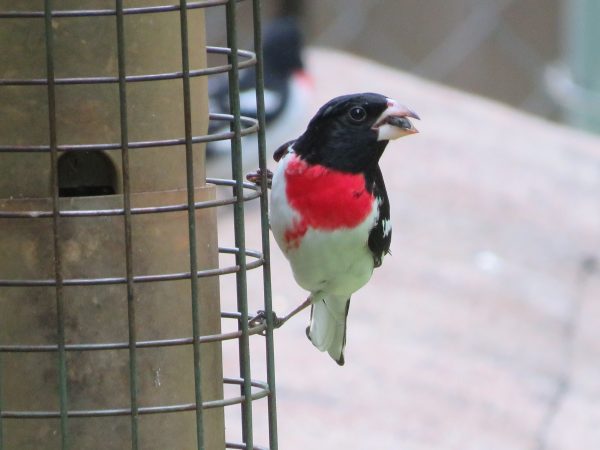A rare encounter with a beautiful bird this spring

If you’ve spent any time in the woods recently, you’ve probably heard some of the neotropical migratory birds who come here in the summertime to breed.
I’ve been hearing black-and-white warblers, and last week heard my first wood thrush of the year. I’ve also heard hooded warblers, northern parulas, scarlet and summer tanagers and red-eyed vireos, among others.
On one recent hike, I saw a fantastic bird up close that I’d not seen in person before – the red-breasted grosbeak (Pheucticus ludovicianus). These birds typically prefer to stay near the tops of trees, so spotting them is not easy. I was fortunate that these birds were using my friend’s bird feeder, dining on birdseed and sunflower seeds. I was able to get some good photographs of them with my camera with the 40x optical zoom. I tried with my phone but was not able to get anywhere near them, as they are pretty skittish.
Rose-breasted grosbeaks are a large, seed-eating bird with a large and strong beak, and males in breeding plumage have a black head and wings, and a white breast with a distinctive splash of bright red. Females and non-breeding males are brown above with two white wingbars, resembling a large sparrow. The female purple finch is frequently mistaken for the female rose-breasted grosbeak.
Rose-breasted grosbeaks are mainly found in eastern North America during breeding season, and prefer open deciduous woods, sometimes in mixed woods, favoring edges or openings with combination of shrubs and tall trees rather than unbroken forest. They migrate to the tropical Americas in the winter.
 A red-breasted grosbeak feeds. Photo: Crystal Cockman
A red-breasted grosbeak feeds. Photo: Crystal Cockman
Adult birds are approximately 8 inches in length, and the call is reminiscent of a robin’s call, though sweeter. Both the male and female rose-breasted grosbeaks share incubation, brooding and feeding duties at the nest. They typically lay four or five purple-spotted, whitish eggs in a nest made of twigs and grass, usually located on a tree branch, anywhere between 3 and 50 feet off the ground. During breeding the male is territorial. Sometimes the male will care for the young while the female constructs a second nest.
Where the range of this species overlaps with that of the black-headed grosbeak on the Great Plains, the two sometimes interbreed. Although they can be parasitized by brown-headed cowbirds, they have been known to displace cowbirds and only a small percentage of their nests have cowbird eggs. Although not endangered, rose-breasted grosbeaks could be vulnerable to loss of habitat. Their current numbers are apparently stable.
Keep an eye out for this striking bird at your own feeder in coming weeks. They are a beautiful treat to see and hear.
Crystal Cockman is director of conservation at Three Rivers Land Trust.